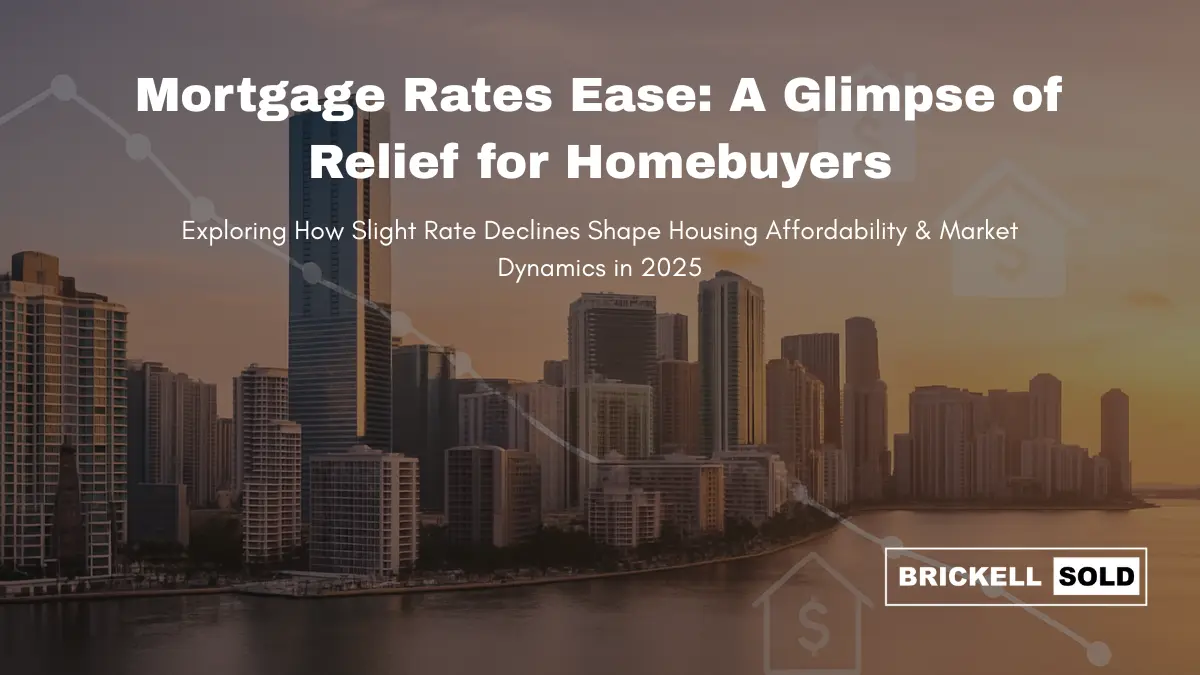Introduction
In the week ending July 31, 2025, a slim measure of relief arrived for homebuyers nationwide. According to Freddie Mac, 30‑year fixed mortgage rates dropped from 6.74% to 6.72%, while the 15‑year rate eased to 5.85% from 5.87%—a small retreat, but meaningful in a housing market still reeling from prolonged rate pressure.
These shifts brought current levels back to where they stood three weeks prior, offering a fleeting moment of optimism in an environment where mortgage affordability has remained stubbornly out of reach. The broader picture? Demand remains soft and transactional momentum slow, with critical implications for buyers, sellers, lenders—and markets like Miami’s Brickell.
In this deep dive, we’ll unpack:
-
What’s behind the rate movement
-
Historical context of current mortgage conditions
-
The interplay of Fed policy, Treasury yields, and rate forecasts
-
The housing demand slowdown and its causes
-
Implications for buyers and renters in Brickell
-
Strategies for navigating the current mortgage environment
-
What to expect in the coming months
Browse affordable new developments and townhomes in the fast-growing Homestead FL real estate market.
Why Did Mortgage Rates Dip? Examining the Drivers
Bond Market Dynamics
Mortgage rates don’t follow the Federal Reserve directly. Instead, lenders track the 10-year Treasury yield, which influences market expectations around inflation and economic growth. With recent readings showing mild cooling in inflation and ongoing debates about Fed rate cuts in September, Treasury yields inched lower—bringing mortgage rates down slightly.
Explore affordable housing and growing communities in Hialeah FL homes for sale with great ROI potential.
Economic Indicators Slow
Inflation metrics have shown some moderation, wage growth has stabilized, and growth projections for the second half of 2025 remain modest. These subtler signals have gradually eased investor anxiety, nudging down rates.
Market Sentiment Globally
Uncertainty around trade, tariffs, and global economics continues to weigh on sentiment. When risk aversion rises, investors favor safe-haven Treasuries—pushing yields lower and mortgage rates in turn.
Check out family-friendly neighborhoods and investment-ready listings in Pembroke Pines FL real estate.
A Look Back: Mortgage Rates in Historical Context
While a 6.72% 30‑year mortgage rate may sound onerous today, it’s important to remember near-historic highs and lows:
-
In mid‑January 2025, the rate briefly climbed above 7%.
-
The low point this year was 6.62% in early April.
-
For perspective: in 1981, the average mortgage rate hit a staggering 18.63%; in contrast, the pandemic-era low hovered around 2.65%.
Even with the recent dip, rates remain elevated relative to pre‑2022 levels—continuing to suppress affordability and buyer appetite.
Discover beachfront condos and gated communities in Hollywood FL homes for sale with instant MLS access.
The Housing Market Response: Demand Stays Soft
Dropping Home Sales & Mortgage Applications
Despite the slight easing, pending home sales fell 0.8% in June, and transactions are down nearly 2.8% year-over-year. Meanwhile, mortgage applications reached their lowest weekly volume since May, though they remain up 21.8% from a year earlier.
View luxury condos, waterfront towers, and gated homes in Aventura FL real estate listings for savvy buyers.
Affordability Strain
The primary burden is still high borrowing costs combined with steep home prices. Today’s median home price of ~$400,000 translates to monthly payments well beyond what many households can comfortably afford—particularly when interest rates remain stubbornly high.
Inventory Still Tight
Low inventory persists as many homeowners sit tight, unwilling to sell and give up loans locked in at older, sub‑4% mortgage rates. This “lock-in effect” contributes to artificial scarcity and keeps prices elevated despite slowed demand.
Find your dream coastal home with top picks from the Fort Lauderdale real estate market—perfect for living or investing.
Market Outlook: Where Savings May Go Next
Forecasted Trajectory
Economists and forecasting groups expect average 30‑year mortgage rates to remain above 6% throughout late 2025. Projections now show an end-of-year average around 6.4–6.5%, with a possible further decline toward 6.0% by 2026.
Invest early in the booming market of Miami new construction homes and condos in top-performing zip codes.
What May Trigger Drops
Future declines hinge on further disinflation, Fed rate cuts (potentially in September), and easing Treasury yields. But absent major shifts, the market consensus envisions mortgage rates hovering in the mid‑6% range through 2025.
Explore the hottest Miami pre construction condos for sale offering luxury, location, and long-term investment value.
Impact on Brickell: Miami’s Luxury-Core Outlook
For Buyers in Brickell
-
Marginal rate drops are welcome, but purchasing power remains constrained. With rates hovering above 6.7%, monthly payments stay high—tempers caution among price-sensitive buyers.
-
Buyers in Brickell, who often come with high incomes or down payments, may feel less rate-driven—but transactions still face affordability ceilings.
Stay informed with the latest trends and opportunities in the Miami real estate investment market from our expert-led blog.
Developer Considerations
-
Pre-construction and branded luxury towers may offer rate buydown incentives or seller concessions to offset borrowing costs.
-
Marketing properties as “lockable rates” or “rate-performance upgrades” might provide a competitive edge in a sluggish market.
Investor Dynamics
-
Investors eyeing short‑term or rental units must reconcile high-cost financing with weaker occupancy and pricing.
-
Long-term rental strategies may hinge on stabilized rates rather than waiting for steep cuts.
Search the best deals in Miami FL real estate for sale including luxury condos, townhomes, and waterfront properties.
What Homebuyers Should Know: Strategy & Timing
Lock-In vs. Wait
Locking at 6.72% may make sense for buyers with rate caps or timing constraints. However, those confident in general market softening toward year-end may prefer adjustable-rate mortgages (ARMs) or refinance options.
Mortgage Application Agility
-
With small rate shifts possible, lock-in periods should align carefully with housing timelines.
-
Buyers should track Fed policy clues, inflation data, and Treasury market movements to time locks.
Discover high-rise living and waterfront options in the Brickell Miami condos for sale updated with real-time listings.
Budget Recalibration
-
Rising mortgage rates have outpaced wage growth and compressed affordability.
-
Buyers may need to recalibrate expectations toward smaller units, lower price bands, or modest down payments to fit financing costs.
Get expert insights on market trends, new projects, and deals in our Brickell Miami real estate blog.
Going Deeper: Broader Structural Insights
Mortgage Rate Trends
Even as rates hover near current levels, cumulative increases from the pandemic low have reshaped home finance permanently. A homebuyer who financed at 3% in 2021 pays hundreds less monthly than one starting at 6.7% today.
Browse curated listings and upcoming developments in Florida pre construction homes for sale across key cities.
The “Lock-In” Effect
A persistent source of inventory stagnation: Millions of current homeowners are locked into ultra-low rates, disincentivizing resale even amid rising equity—a structural constraint on available homes.
Policy Tensions & Fed Messaging
The Federal Reserve remains cautious. Chair Powell has ruled out immediate rate cuts, citing inflation stubbornly above target and labor markets still in balance. Political pressure—especially aimed at Powell—has not swayed the committee yet.
Final Thoughts: Bottom Line for Buyers & Markets
-
Modest relief: A 0.02% dip translates to only nominal improvement in monthly payments.
-
Affordability continues to suffer: Unless deeper downward movement occurs, market inertia will linger.
-
Buyers in fast-moving markets like Brickell should prioritize timing and flexible product strategies (e.g., ARMs or rate locks).
-
Investor sentiment remains strained: Elevated borrowing costs and weak demand require cautious underwriting.
-
Long-term outlook: Any meaningful rebound likely hinges on year-end Fed signals, inflation trends, and Treasury performance.
Conclusion
This week’s slight pullback to 6.72% (30‑year) and 5.85% (15‑year) marks a fleeting moment of reprieve in a protracted cycle of high mortgage costs and constrained housing demand. While borrowers may find some solace in temporarily softer rates, broader affordability challenges persist.
Rich markets like Brickell reflect both sides of this dynamic: high-income buyers with liquidity flexibility coexist with broader market stagnation—driven by subdued lending activity and cautious financing behavior.
As 2025 progresses, homebuyers and investors alike must watch incoming data and policy signals keenly. Flexibility, timing, and strategic rate decisions will matter more than ever in navigating a market shaped by elevated rates and cautious sentiment.

